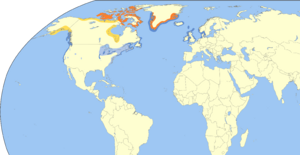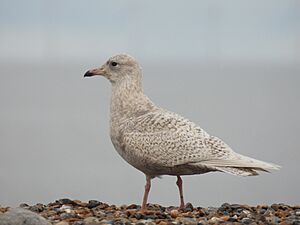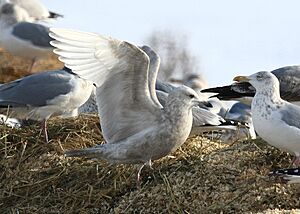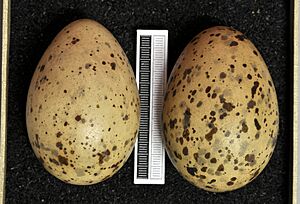Iceland gull facts for kids
The Iceland gull (Larus glaucoides) is a medium-sized gull. It lives and breeds in the cold Arctic regions of Canada and Greenland. Even though it's called the "Iceland gull," it doesn't breed in Iceland. It only visits Iceland during the winter months. The name Larus comes from a Latin word for a large seabird. The name glaucoides means "resembling the glaucous gull." This is because it looks a bit like the glaucous gull, another type of large gull.
Quick facts for kids Iceland gull |
|
|---|---|
 |
|
| Adult, Ithaca, NY | |
| Conservation status | |
| Scientific classification | |
| Genus: |
Larus
|
| Species: |
glaucoides
|
| Subspecies | |
|
|
 |
|
| Distribution
Breeding Migration Nonbreeding Nonbreeding (scarce) |
|

Contents
About the Iceland Gull
The Iceland gull is a medium-sized bird. It is quite slender and not very heavy. These gulls can be about 50 to 64 cm (20 to 25 in) long. Their wings can spread wide, from 115 to 150 cm (45 to 59 in). An adult Iceland gull usually weighs between 480 to 1,100 g (1.06 to 2.43 lb).
It has a smaller and thinner beak than the very large glaucous gull. It is also usually smaller than the herring gull. It takes about four years for an Iceland gull to become fully grown.
What Does it Sound Like?
The Iceland gull makes a "laughing" sound. This call is similar to the herring gull's call. However, the Iceland gull's call is higher pitched.
Where They Live and Travel
Iceland gulls are migratory birds. This means they travel long distances between seasons. They spend their winters in the North Atlantic. You can find them as far south as the British Isles. They also fly to the northern parts of the eastern United States. Some even travel inland to the western Great Lakes in North America.
They are not as common in Europe as the similar glaucous gull.
Reproduction and Life Cycle
Iceland gulls build their nests on coasts and cliffs. They can nest alone or in groups. Their nests are made from grass, moss, or seaweed. They build them on the ground or on a cliff ledge.
Usually, a female Iceland gull lays two or three light brown eggs. As mentioned, they breed in Canada and Greenland. They do not breed in Iceland.
What Do They Eat?
Like most Larus gulls, Iceland gulls eat many different things. They are known as omnivores. Their diet includes fish, small sea creatures like molluscs, and even scraps of food. They also eat eggs from other birds.
They find food by flying over the water. They pick up food from the surface or just below it. They also look for food while walking or swimming. Because they are good at scavenging, they often visit places like garbage dumps. They also look for food near sewage outlets and where fish are cleaned.
Different Types of Iceland Gulls
Scientists group Iceland gulls into different types called subspecies. These are like different varieties of the same bird. The main types found in America include:
- The Kumlien's gull (L. g. kumlieni)
- The Thayer's gull (L. g. thayeri)




